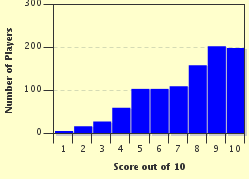Quiz Answer Key and Fun Facts
1. An _________ organism does not require oxygen for growth.
2. What is the name of the inner membrane of an organism that contains a developing fetus and its protective fluid?
3. Which of the following organelles can be seen with a light microscope and a methylene blue stain?
4. If a multicellular organism digests food internally and its cells lack walls, that organism must be an...
5. What protein lowers the activation energy of chemical reactions?
6. Found in both eukaryotic and prokaryotic cells, this combines amino acids into proteins.
7. The loss of electrons by a molecule, atom or ion is called:
8. Salts form when an acid interacts with a:
9. Simple molecules not containing carbon chains or rings, such as water, sulfuric acid, and ammonia, are called...
10. __________ are composed of simple sugars called monosaccharides.
Source: Author
ensiform
This quiz was reviewed by FunTrivia editor
crisw before going online.
Any errors found in FunTrivia content are routinely corrected through our feedback system.

